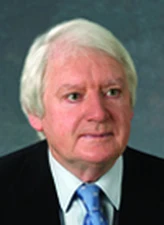J. Ray Bates

The 2009 Vilhelm Bjerknes Medal is awarded to J. Ray Bates in recognition of his pioneering contributions to dynamic meteorology, to numerical methods for weather prediction and climate models, and to climate theory.
Prof. J. Ray Bates has had a long and distinguished career in meteorological and climate research. He has made numerous pioneering contributions in dynamic meteorology, in the development of numerical methods for NWP and climate models, and in climate theory.
Prof. Bates began his research career studying the dynamics of the intertropical convergence. He was the first to model the dynamics of zonally-asymmetric disturbances on the ITCZ and to point out the influence of these disturbances on the zonally-averaged atmospheric state in which they are embedded. His subsequent work discussed the role of tropical disturbances in the general circulation (for which he was awarded the Napier Shaw Memorial Prize by the Royal Meteorological Society in 1971) and generalized the theory of Conditional Instability of the Second Kind (CISK), showing that two separate unstable CISK modes are possible.
Prof. Bates was the first to investigate the possible influence of long-term changes in stratospheric wind or static stability on the tropospheric climate through the mechanism of planetary wave dynamics. Such stratospheric changes could arise from variations in solar UV radiation over the solar cycle, or from changes in ozone concentrations or in the concentrations of greenhouse gases. He showed that, due to planetary wave interference, the amplitude and phase of the topographically-forced long waves at the surface and throughout the troposphere were very sensitive to stratospheric conditions. Prof. Bates also emphasized the importance of a proper treatment of the upper boundary in climate models before this became widely appreciated. His findings have since been confirmed by a number of authors using GCM experiments.
Prof. Bates played a leading role in the early development of semi-Lagrangian numerical methods for atmospheric models. He was the first to provide a formal proof of the unconditional stability of semi-Lagrangian advection schemes using interpolation in the spatially discretized approximations and first to extend the method to two-time-level approximations in a primitive equation NWP model. His pioneering developments let to two-time-level semi-Lagrangian schemes now providing the basis for many of the world’s leading NWP models, including that of ECMWF.
Prof. Bates then played a leading role in the extension of the semi-Lagrangian method to the global domain, showing that the method allowed the pole problem to be overcome in a novel way by using a vector approach. Thereafter, his group developed a multilevel global semi-Lagrangian model that has been used for global NWP and climate experiments.
Prof. Bates developed a novel approach to use PV as a prognostic variable in global semi-Lagrangian models. A shallow water version was shown to have advantages in a stratospheric vortex erosion experiment. There are indications that approaches of this kind offer unique prospects for further progress and might well turn out to be the next major advance in climate and NWP modeling.
Prof. Bates developed a conceptual model of the climate system in which the emphasis is on the surface energy balance, with the role of the surface winds in determining the surface fluxes explicitly represented, and has used this model to study climate stability and climate sensitivity. His recent GCM results show that a dynamical-radiative surface forcing in which the turbulent surface fluxes play as important a role as radiative fluxes is a better predictor of the climate system’s equilibrium response to CO2 increase than the traditional top-of-the-atmosphere radiative forcing. These GCM findings go a long way towards vindicating the surface energy balance approach to zero-order conceptual modeling of the climate system.
Prof. Bates has also carried out a conceptual study of climate feedbacks, showing that a number of definitions that are commonly regarded as synonymous are conceptually distinct and can be of opposite sign. He argues that there is an urgent need for the introduction of internationally-agreed standardized definitions in the area of climate feedbacks.
